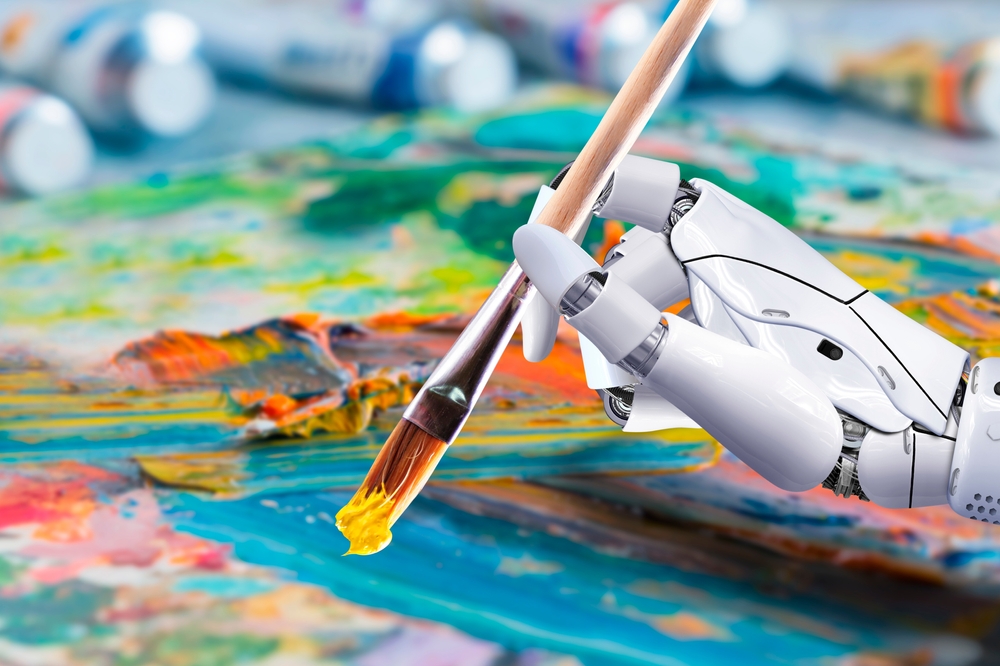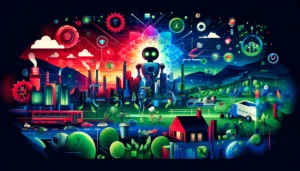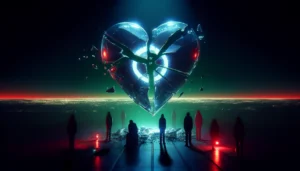The creative industries undoubtedly face disruption from generative AI, but to what extent? And where will it lead?
Timelines and trajectories remain fluid, but as these technologies emulate what we most thought were uniquely human skills, anxiety among creatives is spreading.
Generative AI’s impending impact on the creative sector was acknowledged in early 2023 when the Writers Guild of America (WGA) went on strike in the US.
The WGA represents the country’s entertainment and media writing industry; the strike advocated for fairer rules surrounding streaming payments and protection from AI job losses.
Virginia Doellgast, Professor of Employment Relations and Dispute Resolution at Cornell University in New York, said of the WGA strike, “The fear is that AI could be used to produce first drafts of shows, and then a small number of writers would work off of those scripts.”
At that time, interest in generative AI across Hollywood’s film and TV industry was growing, with the AI on the Lot event in LA demonstrating hundreds of exhibits on how AI will shape the industry.
This included some pretty lewd examples of AI tools generating cartoons, film scenes, animations, and other artwork.
An attendee captured the mood: “Energy at a high, but also anxiety. This is what innovation feels like.”
Later in 2023, the Screen Actors Guild and the American Federation of Television and Radio Artists (SAG-AFTRA) union joined the WGA in the first dual Hollywood strike in 60 years.
AI was a frontline issue, with Hollywood A-listers decreeing an end to the technology’s influence over the creative sector.
Both the WGA and SAG-AFTRA eventually struck deals to curb AI’s impact on jobs for the next few years, but these could prove short-lived as generative AI maintains relentless progress.
Amidst this backdrop of labor disputes, the entertainment industry is also grappling with a wave of layoffs. High-profile companies within the sector, including giants like Riot Games, Unity Software, Amazon MGM Studios, Pixar, and Universal Music Group, announced job cuts within the first few weeks of 2024.
These layoffs were attributed to a variety of factors, including economic pressures, shifting business strategies, and the need to streamline operations in the face of technological advancements.
Companies typically deny the involvement of AI in their decisions to cut jobs – or at least cite it as a short-term catalyst rather than a deciding factor.
For example, when Duolingo laid off workers for AI replacements, the company stated, “We can confirm that some Duolingo workers have not been renewed upon the completion of their projects at the end of 2023. But these are not layoffs. This affected a small minority of Duolingo workers, as the majority have been retained.”
To onlookers in the creative industry, early layoffs are the smoking gun precipitating an imminent avalanche of job losses.
A collective groan of uneasy acceptance has rung out across the creative industries: “It begins.”
Understanding the extent of AI job losses for the creative industry
What evidence do we have of AI-related job losses in the creative industries besides anecdotes?
Data on AI’s impacts on jobs remains thin, but there are several studies we can look at.
One recent study, Future Unscripted, drew on 300 leaders across the entertainment industry and found that California alone will feel the full force of AI-related job losses in the US, with 62,000 jobs within film, television, music, and gaming being disrupted over the next three years.
This figure balloons to an estimated 204,000 jobs nationwide, highlighting a broader trend of technological upheaval across the sector.
And there it is. Study shows 204,000 entertainment jobs will be disrupted by AI over the next 3 years. Some of the most impacted people in film are artists like me and my friends. When someone hand waves your concerns, show them this study. Be loud. https://t.co/wcSUZmgtop pic.twitter.com/asAbIkY6sc
— Reid Southen (@Rahll) January 31, 2024
The Animation Guild commissioned the study and intends to use it to fortify its defenses against AI, which indicates it isn’t the most objective analysis.
However, predictions are the best we have until job losses pick up pace and objective evidence comes to the fore. The figures don’t seem hyperbolic or unrealistic.
#AI Impact Alert! Our study with Concept Art Assoc reveals a job quake in #entertainment! #Workers must have a voice at the table! https://t.co/5lJy5henJ0#UnionStrong @IATSE #ValueArtists pic.twitter.com/J9YERr8xmW
— The Animation Guild // #WeAre839 (@animationguild) January 30, 2024
The report also touches on specific sectors within the entertainment industry. The film, television, and animation sector, with a workforce of nearly 550,000, will suffer some of the worst effects, with 21% of jobs disrupted by 2026 due to the integration of generative AI into tasks like 3D modeling, character design, and voice generation.
Some 44% of firms in this sector already use generative AI for 3D modeling tasks and 39% for character and environment design.
In music and sound recording, generative AI adoption is slower, with an expected 1,800 jobs at risk by 2026. Voice generation, a field led by companies like ElevenLabs, will have a key impact here.
The gaming industry, characterized by rapid technological evolution, embraces generative AI, with 86.7% of firms identified as early adopters. By 2026, AI could impact 13.4% of this sector’s workforce, or 52,400 jobs. We’ve seen generative AI products from leading game design platforms like Unity, which was criticized last year for ripping off artists’ data in an effort to replace them.
Brandon Jarratt, a prominent figure on the Animation Guild’s executive board and its AI task force, said of the report, “The data is a window into the attitudes and intentions of the most powerful people in the industry when it comes to AI.”
He further elaborated on the underlying fears associated with AI, attributing them to the studios’ relentless pursuit of cost-cutting measures to fulfill financial projections, which could potentially exploit AI technologies.
Nicole Hendrix, co-founder of the Concept Art Association, who found the findings “chilling,” also said, “When you’re looking at any technology that’s essentially replacing [or consolidating] a junior or entry-level role … it is harming the ecosystem.”
A few other studies have assessed AI job losses. A recent MIT study found AI-related job losses in ‘vision-related’ fields would hit 40% of some sectors by 2030, and the WEF found some 60% of jobs in ‘advanced economies’ could be affected without intervention.
Low-wage jobs in the US could be practically eliminated by 2030, says another report, and IBM said some 40% of people in some sectors will need to re-skill.
3,900 out of 80,000 corporate lay-offs were attributed to AI in May last year, according to an employment report.
There’s sure to be more concrete evidence this year.
Creative philosophies in the generative AI era
Another incident was chucked into the melting pot when Midjourney, which develops AI image generation models, was exposed for using the styles of 16,000 artists without their consent.
Artists were reeling from the ramifications of this disclosure when a study exposed Midjourney’s proficiency in generating near-perfect clones of copyrighted work.
Cognitive scientist Dr. Gary Marcus and concept artist Reid Southen released their study in IEEE titled “Generative AI Has a Visual Plagiarism Problem.” It revealed that even vague prompts could see MidJourney precisely recreate blatantly copyrighted work.
Dr. Marcus recently said on X, “When I started working on AI four decades ago, it simply didn’t occur to me that one of the biggest use cases would be derivative mimicry, transferring value from artists and other creators to megacorporations, using massive amounts of energy. This is not the AI I dreamed of.”
Generative AI is provoking introspection about what creativity and art mean in an era where near-perfect copies of any digital work are but a prompt away.
Digital artists are already closing up shop and reskilling, not just because their jobs are under pressure but because the soul of their craft has been brought into disrepute.
This spotlights deeper, more existential concerns about the essence of creativity, artistic integrity, and the sanctity of intellectual property, and within this debate, we’ve caught a glimpse into the deeper philosophical underpinnings of art and aesthetics in the era of generative AI.
It brings to mind Hannah Arendt’s seminal work, “The Human Condition,” where she delineates human activities into labor, work, and action. Arendt categorizes “work” as creating durable objects that contribute to the human-made world – a world where AI can now contribute.
Arendt’s philosophy prompts us to question whether creations devoid of human intentionality and lived experience can truly embody the depth and richness that define artistic expression. The controversy surrounding Midjourney’s appropriation of artist styles without consent mirrors her concerns about the value and authenticity of art in the age of AI reproduction.
Worry about generative AI’s erosion of human creativity echoes in the works of other post-modernist thinkers like Michel Foucault, Jean-François Lyotard, and, more recently, Neil Postman, whose “Technopoly: The Surrender of Culture to Technology” critiques the uncontrolled growth of technology, suggesting that it undermines critical thinking, reduces complex cultural practices to mere transactions, and erodes the foundations of social institutions.
Along these lines, Arendt said of the industrially modernized age, “All the values characteristic of the world of fabrication – permanence, stability, durability…are sacrificed in favor of the values of life, productivity, and abundance.”
As Professor Roger Berkowitz, writing for the Hannah Arendt Center for Politics and Humanities, explained, “We labor by necessity; we work to create a human reality.”
It’s an ironic twist of fate, as AI has often been marketed as doing the opposite: automating hard labor so humans can focus on their more personal and creative pursuits.
OpenAI CEO Sam Altman even said he was wrong about this, confessing that he didn’t imagine AI would seize creative workflows so effectively.
“Creativity has been easier for AI than people thought,” Altman said at the Wall Street Journal’s Tech Live conference in October 2023.
Of course, there is the counter-view that AI is set to augment the human experience and transcend what it means to be human – something that conjures both eutopic dreams and dystopian nightmares.
Much as tools like word processors and Adobe suites enhanced workflows vs. fully replacing writers and designers, the thinking is that AI can address drudgery without usurping truly human ideation skills anytime soon.
To give a fair hearing to those who aren’t so sympathetic to AI-related job losses, humanity has witnessed similar transitions that challenged the essence of creativity and its mediums.
Take the music industry, for example, when sampling and electronic music production democratized music creation. Critics blasted the sampling process (and still do), but it developed genres of music we now take for granted.
Then there was the CD, the MP3 player, and so on and so forth. Vinyl is stronger than 20 years ago, and tape cassettes are making a comeback.
You just can’t kill forms of tangible creative work. At least not permanently. Creativity is antifragile. AI is another test, at least in a philosophical sense, for all that won’t ease the fears of those facing job losses.
There is also the potential for AI to unleash a new creative order by concentrating even greater effort, appreciation, and value in authentic human work.
As electronic and ambient music pioneer Brian Eno famously described, “Whatever you now find weird, ugly, uncomfortable, and nasty about a new medium will surely become its signature. CD distortion, the jitteriness of digital video, the crap sound of 8-bit – all of these will be cherished and emulated as soon as they can be avoided.”
“It’s the sound of failure: so much modern art is the sound of things going out of control, of a medium pushing to its limits and breaking apart.”
Will generative AI follow this pattern? Possibly, but artists are still right to be skeptical. They’re taking matters into their own hands and using tools like the University of Chicago’s Nightshade to ‘poison’ AI models from the inside.
Might we see the formation of some sort of anarcho-primitive movement consisting of newly converted Luddites who have lost their jobs – more – their life’s work and meaning – to generative AI?
History tells us that creativity overcomes seemingly immovable objects. It’s evolved despite the harshest realities modern humans have faced over our 100,000-year history.
AI might eventually create a new history, but creativity remains under human control, for now at least.





